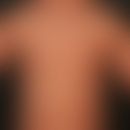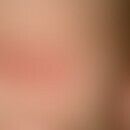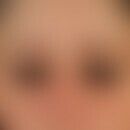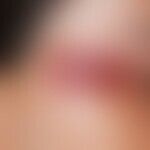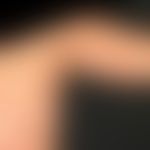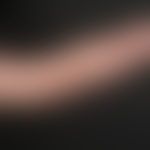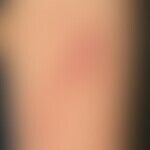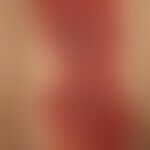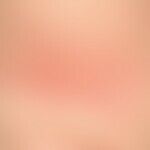Synonym(s)
DefinitionThis section has been translated automatically.
Non-recoverable vascular, primarily capillary malformation (CM), which is visible at birth or manifests itself at a later age, but can also affect venous and/or arterial vascular systems of the skin and/or other organs. S. and vascular malformations.
ClassificationThis section has been translated automatically.
From a clinical point of view, the following entities can be distinguished in asymmetric capillary malformations:
Nevus flammeus asymmetric homogeneous flat "port-wine" type
The telangiectatic type
-
Nevus flammeus with associated symptoms
-
Phacomatosis pigmentovascularis
- Type I: Nevus flammeus combined with nevus pigmentosus verrucosus
- Type II: Nevus flammeus combined with Mongolian spot (dermal melanocytosis)
- Type III: Nevus flammeus combined with nevus spilus
- Type IV: Nevus flammeus combined with nevus spilus and Mongolian spot, possibly also nevus anaemicus.
- Naevus vascularis mixtus (vascular twin nevus): Rare clinical picture characterized by the combination of a naevus flammeus with a naevus anaemicus .
- Klippel-Trénaunay syndrome
- Sturge-Weber-Krabbe syndrome
- Proteus syndrome (port wine nevus of the Proteus type)
- Clove syndrome (port wine nevus of the CLOVES type)
Megalencephaly-capillary malformation-polymicrogyria syndrome
-
Phacomatosis pigmentovascularis
You might also be interested in
Occurrence/EpidemiologyThis section has been translated automatically.
Capillary malformations (KM) occur in about 0.3% of the population (exact epidemiological data are not available). There is no gender preference.
ClinicThis section has been translated automatically.
Mostly bizarrely configured, in the first years of life light red, later saturated red to blue-red (red wine-coloured) spot (completely compressible by glass spatula printing). The size ranges from 0.5 cm in diameter to large-scale spots extending over wide areas of the body. Bizarre formations can occur. An arrangement in the Blaschko lines does not exist.
A nevus flammeus does not show spontaneous surface growth, but only enlarges according to the body growth. After decades of existence, growth phenomena appear in the vascular malformations. Bumpy, blue-red plaques, papules or nodules form. There is a tendency to bleed from trivial injuries.
TherapyThis section has been translated automatically.
Pale nevi (infancy and childhood): The best successes are shown with the pulsed dye laser (585 nm or 577 nm, see also Laser). Disadvantage: Financially expensive, available only in specialized institutions. Lightening effects in about 70% of nevi. Scarring occurs very rarely with proper use. Nevi on the head, trunk or neck respond best. Sufficient are usually 5-7 sessions in intervals of 6-8 weeks with energy densities of 5,5-8 J/cm2, depending on the best lightening after previous test lasing (1 cm2). Preparation: Especially in children, due to painfulness, prior administration of local anesthesia (e.g. EMLA cream) is often used, if necessary also systemic analgesics or general anesthesia. However, local anesthesia (injection or cream) should be avoided if possible, since the resulting vasoconstriction will reduce the availability of the target chromophore (hemoglobin) for the laser and thus the effect is to be considered lower. However, 10-year results show that nearly 60% of laser-treated nevi flammei darken again.
Dark nevi (adult age): Dark nevi often respond relatively well to argon laser. A prolonged treatment is usually necessary. The response can often only be assessed after several sessions. The risk of scarring and hypopigmentation can be greatly reduced by careful dosing. If the response is insufficient, pulsed dye lasers may be considered. Here, too, 5 or more sessions are usually necessary. Nodular areas respond only slightly; here, more can be achieved with Photoderm VL (high-energy flash lamp with a broad wavelength spectrum).
Before starting laser treatment: Inform the patient about discoloration persisting for 1-2 weeks, avoid direct sun exposure and use light protection (e.g. Anthelios) for the entire duration of laser treatment. Alternative: Cosmetic covering e.g. with Dermacolor. Use cryosurgery only if you have sufficient experience with the therapy.
Clarification and, if necessary, treatment of accompanying anomalies, see below respective syndrome.
Progression/forecastThis section has been translated automatically.
Note(s)This section has been translated automatically.
Remember! A facial nevus flammeus is a compelling indication for ophthalmologic clarification (glaucoma, retinal damage). The dogma that facial nevi flammei reflect the trigeminal dermatomes V1, V2 and V3 has apparently been rightly questioned (Happle R 2014). Patients treated with laser should be made aware of a possible darkening of the areas.
The common nuchal-frontal capillary malformations on the neck or upper eyelids (Unna spot/salmon spot/angel kiss), formerly known as "naevus flammeus medialis", are completely harmless. In most cases, the capillary Unna spot persists for life.
LiteratureThis section has been translated automatically.
- Happle R (2014) How common are genetic mosaics of the skin? dermatologist 65: 536-541
- Huikeshoven M et al (2007) Redarkening of port-wine stains 10 years after puls-dye-laser-treatment. N Engl J Med 156: 1235-1240
- Katugampola GA et al (1996) The clinical spectrum of naevus anaemicus and its association with port
winestains: report of 15 cases and a review of the literature. Br J Dermatol 134:292-295. - Larralde M et al (2014) Capillary malformation-arteriovenous malformation: a clinical review of 45 patients. Int J Dermatol 53:458-461.
Incoming links (18)
Angiomas trigémine osteohypertrophique; Bonnet-dechaume-blanc syndrome; Cobb syndrome; EPHA3 gene; GNAQ gene; Haemangioma planum; Hemangioma simplex; Hyperaemic nevus; Mixed nevus vascularis; Naevus; ... Show allOutgoing links (21)
Analgesics; Argon laser; Asymmetrical nevus flammeus; Camouflage; Cloves syndrome; Cryosurgery; Hypopigmentation; Klippel-trénaunay syndrome; Laser; Light protection; ... Show allDisclaimer
Please ask your physician for a reliable diagnosis. This website is only meant as a reference.
